A powerline ethernet adapter is a network bridge that transmits the internet over the power lines running through the walls in your home. It’s a way to send the internet connection from your router to devices around your home without running ethernet cables around that space.
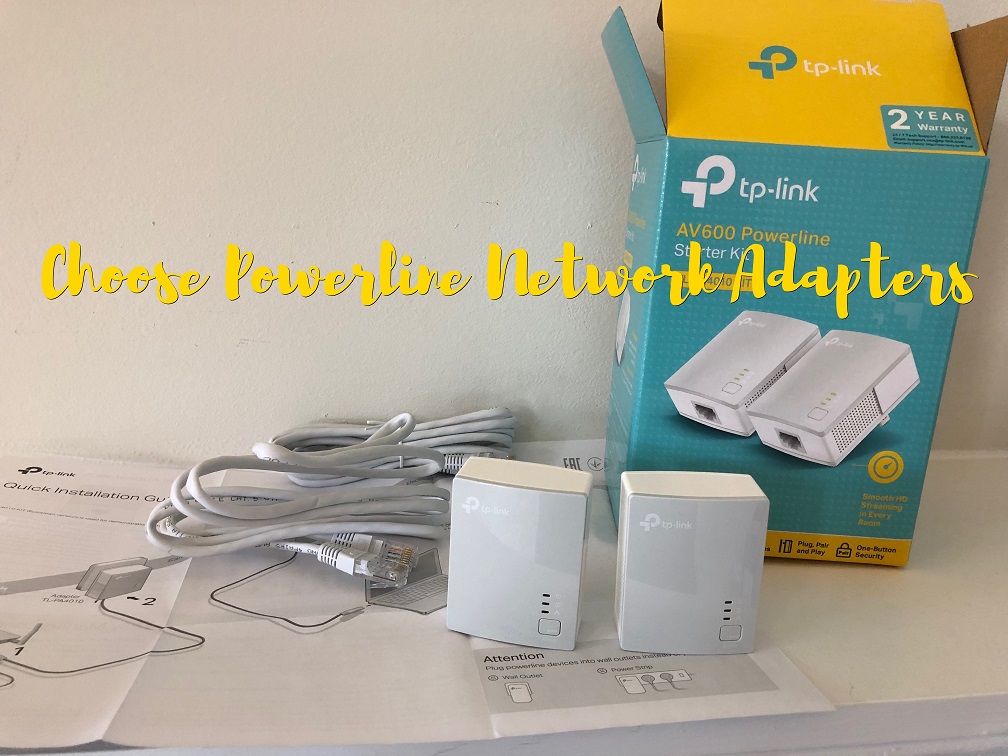
If you’re one of my regular blog followers, you might already know that I just moved into a beautiful large new home.
As much as I love my new home, one major struggle I’ve faced is setting internet access around the entire space.
I’ve been experimenting with different internet extending devices to spread WiFi around my home and into my detached garage.
One of the most effective options I’ve tested so far is the powerline networking adapter.
Powerline Adapters make spreading the internet from one section of my home to another quick and easy using your current home electrical wiring.
In this article, I’ll outline how powerline networking works, how to choose an adapter, how you install it.
Also, what sort of experience you can expect from the powerline adapter technology, and what type of difficulties you might run into when installing such a system in your own home.
Recommended Powerline Network Adapters:
| Category | Name | Product |
|---|---|---|
| Money is no object | TP-Link Powerline Adapter AV2000 |  |
| For the masses | TP-Link AV1000 Powerline Ethernet Adapter |  |
| Budget pick | TP-Link AV600 Powerline |  |
| Other options | Netgear 2000 Mbps, Zyxel AV2000 |
Keep reading to learn how effectively you can use your home powerline to set up an Internet network.
What are Powerline Adapters?
A powerline ethernet adapter is a network bridge that transmits the internet through the power lines that run through your home’s walls.
It’s one of the easiest ways to send internet connections from your router to devices around your home without ethernet cables running around the house. The technology behind powerline adapters is advanced, and getting the devices to work in your home or business is simplified.
Reliable Powerline Networking adapters now are capable of real-world transfer speeds between 200 Mbps and 350Mbps. Network over powerline is one of the easiest and cheapest ways to extend your internet connection instead of running a traditional ethernet cable.
How a powerline Adapter works
Each powerline adapter comes as a set pair, a transmitter, and a receiver in each set.
The transmitter is connected to your home’s router using an ethernet cable, or through a wireless connection, this gives the transmitter internet access. It connected to your home’s electrical wiring by plugging it into the nearest outlet.
The receiver connects to the electric outlet of your house where you like to extend your Internet.
Pair the transmitter and receiver to one another, and the two devices will begin sending your internet connection through your home’s power lines.
You can wire a computer/TV to your receiver and convert this as your LAN Connection, or you can use it as a wireless access point.
These adapters can be used to create a stable internet connection that extends from one side of your home to the other, which is much more convenient than trying to run ethernet cables all over your home.
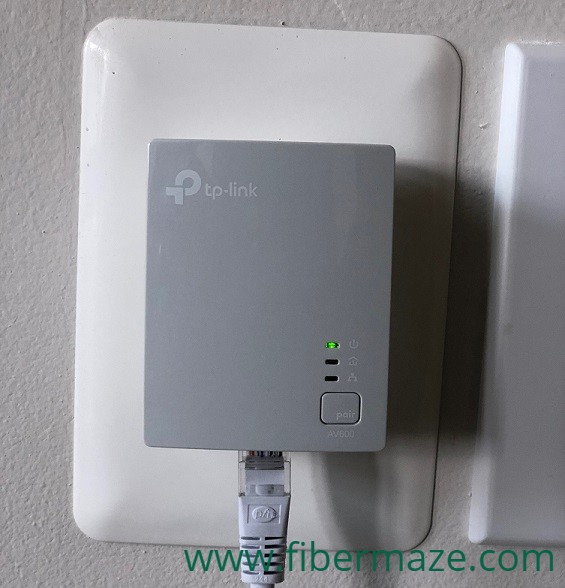
Step by step Powerline Adapter Installation using Ethernet Cable:
The simplest way to install a powerline adapter is by using two sets of ethernet cables, but you must wire your devices directly and can’t use wireless devices with this setup. If that sounds okay to you, you can follow the following steps to get our adapters running properly.
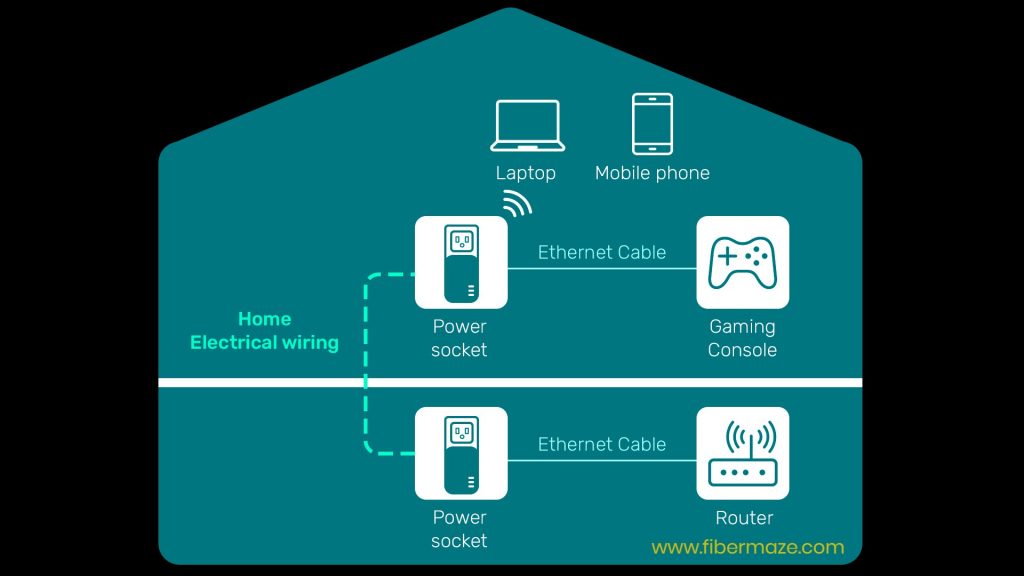
- Plug the first half of the adapter set into the outlet nearest to your home’s router
- Attach an ethernet cable to one of the outgoing ethernet ports on the back of your router
- Attach that ethernet cable from Router to the powerline adapter’s ethernet port.
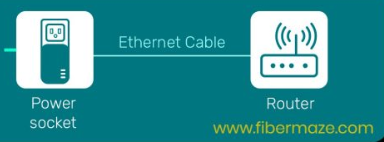
- Plug the second powerline adapter into an outlet in a different room as close as you can to the other device(Desktop, Gaming Console, TV Unit) you want to connect to your home network
- Attach an ethernet cable to your computer, game system or whatever device you want to connect.
- Plug that same ethernet cable into the powerline adapter that’s already plugged into your wall
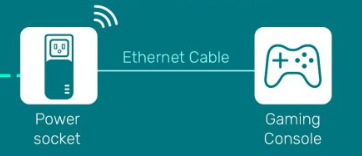
- Press the pair button on both the receiver and the transmitter to complete the connection.
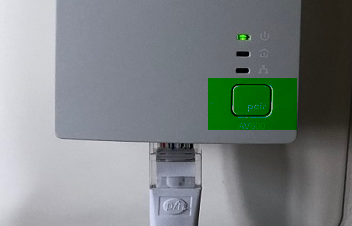
- You should now have a stable internet connection running from your router, through your home’s wiring, and to your device
When powerline adapters were first released, they were limited to transfer speeds of up to 14 Mbps, which is pretty slow by today’s standards. Fortunately, technology has advanced noticeably. Today it’s possible to get devices rated at over 1Gbps, though you won’t achieve those sorts of speeds in most applications.
In real-world applications, you shouldn’t expect more than 150Mbps or 350Mbps by running one of the adapter sets.
Generally, when running your internet connection across your power lines with powerline adapters, you would expect to lose 50 percent or more of the rated speed.
The farther the connection has to go, the weaker the signal becomes.
Generally, you can’t send a signal farther than 300 meters with these connections, and you should try to limit your total travel distance to 200 meters or less whenever you can.
If you can maintain decent conditions, you can likely get speeds around half the rated speeds on the adapter. That means if you’re trying to achieve a transfer speed of 200 Mbps, you will need a device rated for at least 400 Mbps or more.
Select a powerful network adapter to support gaming PS4 and streaming over the internet, and try not to expect speeds that are close to the speed rating on the product. You may suffer from issues with interference and poor wiring that will limit your rates even more.
Select a powerful network adapter to support gaming PS4 and streaming over the internet, and try not to expect speeds that are close to the speed rating on the product. It’s possible that you will suffer from issues with interference and poor wiring that will limit your speeds even more.
Is Powerline Networking is an option for your Home?
Any time that you make use of powerline adapters you have a bunch of potential issues to worry about. There is device interference, poor wiring quality, going past the limited range of wiring and AFCI circuit breakers.
Dealing with Device Interference:
One of the first and most significant is interference. Devices like microwaves and others with electromotors will interrupt signals from these adapters. If these devices are on the same circuit as your powerline adapters, you should plug them into surge protectors to limit the noise interference.
Cell phone and tablet chargers also cause significant interference and are best left plugged into other circuits whenever possible. At the very least, you should try and keep the rest of the plugs on the outlet you are using free from devices to minimize interference.
Poor Connections due to Old Wiring:
Old wiring can also cause severe issues for your powerline adapters. It can lead to problems with speed and connection quality, and This is something you can’t change quickly. Hence, you need to hope that your transfer speeds are decent through your home, and if they aren’t weak, the wiring could be the culprit.
AFCI Circuit Breakers:
In some cases, AFCI circuit breakers can actually block the internet connection sent by a powerline network adapter. If you aren’t getting an internet connection through your chosen outlets, it’s likely because of the AFCI protection. Try attaching your powerline adapter into a plug on a different circuit to see if that solves your issue. If you have a circuit without AFCI protection you shouldn’t have the problem any longer.
How to Improve Powerline Adapter performance:
To minimize interference and achieve the fastest network connection speeds with a powerline adapter set, follow these best-practices whenever possible.
- Try and run your internet connection along a single electrical circuit in your home.
- Attach the adapter ends into outlets with no other devices plugged in
- Avoid circuits with AFCI protection
- Limit the network transfer distance to 200 meters whenever possible and don’t go over 300 meters.
- Plug microwaves and other devices that can interfere with your internet connection into surge protectors or extension cords 20 feet or longer.
Powerline adapters can be very useful tools for transferring an internet connection across your home when you don’t want to put holes in your walls to run ethernet cables. It might take you some time to figure out the perfect spot to set up your receiver to get a good solid connection speed, but with trial and error, you can get great results with these devices.
Don’t be discouraged if you have issues with your adapter set when you first install it, move the adapters around, try to reduce devices causing interference and eventually you might be able to achieve a really stable internet connection with this solution.
Frequently Asked Questions:
Can you mix powerline adapters?
You can mix powerline adapters and make them work in some instances, but it’s a poor practice. Mixed adapters often aren’t compatible, and you are limiting your connection to the slowest speed of all the adapters.
Can I have more than 2 powerline adapters in the same building?
Yes, it is possible to have more than two powerline adapters in the same building when using devices set with different passcodes. It’s important to note that you will share the bandwidth available between all the devices connected, meaning everyone will get slower network transfer speeds.
Can you plug powerline adapters into extension cords?
No, powerline adapters must be installed right into your electrical outlet. An extension cord will dramatically reduce speeds or keep the adapters from functioning at all.
Are powerline adapters as fast as a wired ethernet cable?
No, generally ethernet cable is significantly faster than powerline adapters are. That’s because there is much less interference across the lines, and they are more direct from point to point than powerline connections are.
Are powerline adapters reliable enough for gaming?
Yes and no. Some powerline adapters are more than reliable enough for gaming, while others are plagued with too much interference and suffer from dropped connections. It depends on the quality of the power lines and the distance to be covered.
